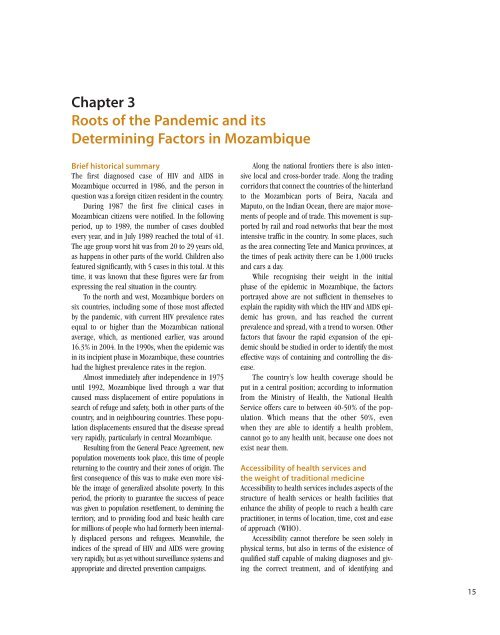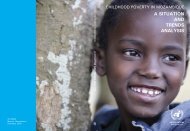English language version - Human Development Reports - United ...
English language version - Human Development Reports - United ...
English language version - Human Development Reports - United ...
- No tags were found...
You also want an ePaper? Increase the reach of your titles
YUMPU automatically turns print PDFs into web optimized ePapers that Google loves.
Chapter 3Roots of the Pandemic and itsDetermining Factors in MozambiqueBrief historical summaryThe first diagnosed case of HIV and AIDS inMozambique occurred in 1986, and the person inquestion was a foreign citizen resident in the country.During 1987 the first five clinical cases inMozambican citizens were notified. In the followingperiod, up to 1989, the number of cases doubledevery year, and in July 1989 reached the total of 41.The age group worst hit was from 20 to 29 years old,as happens in other parts of the world. Children alsofeatured significantly, with 5 cases in this total. At thistime, it was known that these figures were far fromexpressing the real situation in the country.To the north and west, Mozambique borders onsix countries, including some of those most affectedby the pandemic, with current HIV prevalence ratesequal to or higher than the Mozambican nationalaverage, which, as mentioned earlier, was around16.3% in 2004. In the 1990s, when the epidemic wasin its incipient phase in Mozambique, these countrieshad the highest prevalence rates in the region.Almost immediately after independence in 1975until 1992, Mozambique lived through a war thatcaused mass displacement of entire populations insearch of refuge and safety, both in other parts of thecountry, and in neighbouring countries. These populationdisplacements ensured that the disease spreadvery rapidly, particularly in central Mozambique.Resulting from the General Peace Agreement, newpopulation movements took place, this time of peoplereturning to the country and their zones of origin. Thefirst consequence of this was to make even more visiblethe image of generalized absolute poverty. In thisperiod, the priority to guarantee the success of peacewas given to population resettlement, to demining theterritory, and to providing food and basic health carefor millions of people who had formerly been internallydisplaced persons and refugees. Meanwhile, theindices of the spread of HIV and AIDS were growingvery rapidly, but as yet without surveillance systems andappropriate and directed prevention campaigns.Along the national frontiers there is also intensivelocal and cross-border trade. Along the tradingcorridors that connect the countries of the hinterlandto the Mozambican ports of Beira, Nacala andMaputo, on the Indian Ocean, there are major movementsof people and of trade. This movement is supportedby rail and road networks that bear the mostintensive traffic in the country. In some places, suchas the area connecting Tete and Manica provinces, atthe times of peak activity there can be 1,000 trucksand cars a day.While recognising their weight in the initialphase of the epidemic in Mozambique, the factorsportrayed above are not sufficient in themselves toexplain the rapidity with which the HIV and AIDS epidemichas grown, and has reached the currentprevalence and spread, with a trend to worsen. Otherfactors that favour the rapid expansion of the epidemicshould be studied in order to identify the mosteffective ways of containing and controlling the disease.The country’s low health coverage should beput in a central position; according to informationfrom the Ministry of Health, the National HealthService offers care to between 40-50% of the population.Which means that the other 50%, evenwhen they are able to identify a health problem,cannot go to any health unit, because one does notexist near them.Accessibility of health services andthe weight of traditional medicineAccessibility to health services includes aspects of thestructure of health services or health facilities thatenhance the ability of people to reach a health carepractitioner, in terms of location, time, cost and easeof approach (WHO).Accessibility cannot therefore be seen solely inphysical terms, but also in terms of the existence ofqualified staff capable of making diagnoses and givingthe correct treatment, and of identifying and15
















